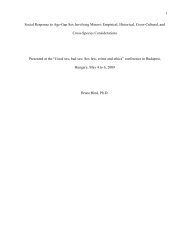Infant and Child Sexuality: A Sociological Perspective - Ipce
Infant and Child Sexuality: A Sociological Perspective - Ipce
Infant and Child Sexuality: A Sociological Perspective - Ipce
Create successful ePaper yourself
Turn your PDF publications into a flip-book with our unique Google optimized e-Paper software.
ing attitudes, conversations, <strong>and</strong> actions of the<br />
six through twelve age group, which is supposedly<br />
the latency period, the more convinced I am<br />
that Freud was at least somewhat astray on this<br />
aspect of his theory.<br />
Data on overt heterosexual play, including coital play with or<br />
without penetration, does not support the notion of a latency period<br />
either. Ramsey <strong>and</strong> Kinsey show no evidence of striking increase in the<br />
incidence of such activity as puberty is reached. Kinsey’s data on the<br />
active incidence for each year did show that for boys who later go to<br />
college, heterosexual play of all kinds dropped off after about age<br />
ten, presumably in response to a redefinition of the meaning of this<br />
type of behavior. But, among boys who did not finish high school there<br />
was reportedly little withdrawal <strong>and</strong> a high level of continuity of heterosexual<br />
activity through preadolescence <strong>and</strong> into adolescence. There<br />
are sexual differences, however. Among males a very much larger percentage<br />
carried their preadolescent play directly into their adolescent<br />
<strong>and</strong> adult activities than was true of females. The discontinuities<br />
between the adolescent <strong>and</strong> preadolescent activities of the female appear<br />
to be the products of social custom <strong>and</strong> not of anything in the female’s<br />
biological or psychological makeup.<br />
Perhaps it was because I was approaching the age<br />
of puberty, but all of a sudden my parents would<br />
not allow me to engage in any of the boy-girl<br />
activities.<br />
For many, “sexual awakening,” that is the dawning consciousness of<br />
members of the opposite sex as appealing sexual <strong>and</strong> erotic partners,<br />
comes about in adolescence. But for some it is very real <strong>and</strong> poignant<br />
during preadolescence (<strong>and</strong> earlier as documented in earlier chapters).<br />
The heterosexual “awakening” that comes to many during preadolescence<br />
is well expressed by a rural midwestern boy.<br />
As our sixth grade progressed we were thrown<br />
together many times for long bus rides as part of<br />
the school b<strong>and</strong> <strong>and</strong> that summer proved our undoing.<br />
It was truly the summer of our discontent. The<br />
b<strong>and</strong> began its rounds of parades, each of which<br />
carried with it a magical third world of fantasy<br />
called a carnival. On these hot afternoons, our<br />
group would make the circuit of the fair grounds<br />
trying our skill at the various games of chance,<br />
only to be followed by an innocent group of girls.<br />
Our desire to prove athletic supremacy within the<br />
group spread to a desire to please our shadowy<br />
female following. We had all known our prospective<br />
positions within our clique before, but now a new<br />
frontier was upsetting the balance of power <strong>and</strong> the<br />
fight for status was on. Little did we know our<br />
future was already laid out for us. When the girls<br />
noticed our exposed intentions, they were quick to<br />
tie the noose <strong>and</strong> there was no escape. That summer<br />
two worlds fused into one which was entirely different<br />
than anything that I had experienced before.<br />
We did everything as a group.<br />
124
















